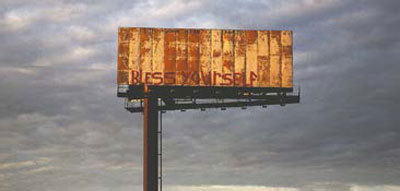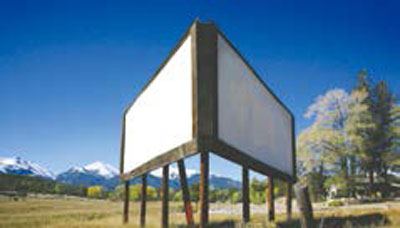Artist deciphers blank billboards from a bygone era
Updated: 2012-09-14 11:05
By Kelly Chung Dawson in New York (China Daily)
|
|||||||||
|
|
In the second half of the 20th century, roadside billboard advertisements were ubiquitous, but in recent years, changing technology and the economic downturn have rendered them less relevant as a commercial medium. The result has been a landscape dotted with blank billboards.
In a new exhibition entitled "I Am Your Mirror" at New York's Vilcek Foundation Gallery, Chinese artist O Zhang displays photographs of thousands of blank billboards from all over the country, taken over two years.
"That commercialism of the decades after World War II is a fading dream now," Zhang said in an interview with China Daily. "The economic boom is gone, and the entire world is going downhill. When I started to notice empty billboards, I thought they were beautiful and sad. I felt that they have a message about a moment in American history."
The exhibition features both framed photographs and weather-treated prints in scattered piles under an actual abandoned billboard. Visitors are encouraged to examine the prints, to walk on them and treat them as a landscape.
"She has evoked what she encountered out on the road," said Rick Kinsel, executive director of the foundation. "She found physical evidence in these rough, empty billboards that the country has been shaken. She subsequently recreated that feeling in the gallery as a foreign-born artist tackling two wholly uniquely American subjects: the American road trip, and billboards. These billboards are not only symbols of a struggling economy, but they are also relics from a booming time in America's history."
In a 10,000-mile road trip, Zhang drove from California to New Orleans; through Memphis, Georgia, North and South Carolina, and Virginia. "The trip made me feel very American," she said. "I love the landscape here in America. It's so beautiful, and there are so many different kinds of landscapes. I really fell in love with this country."
Although the exhibition is imbued with a certain melancholy at first glance, Zhang believes that the symbolism of the billboards is entirely open for interpretation.
"For me, the good thing about the blankness of the boards is that people might project their own feelings there," she said. "It's a reflection of how we feel about this time. Some people might look at the blankness as an opportunity for a new beginning, and the end of an aggressive commercial era."
She added: "Now that you see more and more with no message at all, it feels a bit like we have no future or perhaps that we don't know what the future holds anymore. It's up to us to project our own future, and I like that message. Do we want our future told? Or is it better that we don't have answers about what the future might be?"
The exhibition is ultimately hopeful, Kinsel said. "Yes, these billboards are abandoned and decayed, but they're still there. They're permanent, and strong. They might be time-worn and layered with decades of history and past advertisements, but they are firmly part of the American landscape. It's an optimistic message."
Kinsel believes that Zhang's Chinese perspective is evident in the exhibition. "Only a foreign-born person would have seen that meaning there. Additionally, O is an artist with a resonant, artistic voice. She has something to relate to the world. I think that her Chinese background gave her the ability to see the entire project more clearly. No one else would have seen something so interesting in these big, empty billboards."
The exhibition is the artist's first project with no link to Chinese subject matter, but she did think about the contrast between the Chinese and American landscapes, Zhang said.
"I am very much Chinese, and I could not help but see the differences," she said. "In China you don't see blank billboards. You see all kinds of messages; it's very noisy, and busy. We might see a similar slowdown in China over the next year or two, but right now it's very energetic. I wouldn't say I have a unique perspective, but I am a Chinese person thinking about America."
Additionally, her training in classical Chinese painting continues to shape her perspective, Zhang said.
"In Chinese painting, blankness is not only blankness," she said. "It can be the most important element of a piece. Sometimes blankness is fog, or rain. You have to know when leaving empty space is more useful, and I think that aesthetic is always in my mind when I shoot American landscapes. I see the absence not as a sad thing, but as a message. I think these empty billboards have life. They speak to the current moment and the world we live in. It's a different time, because the whole world is a bit lost. No one is telling us, 'It's going to be ok.' I wanted to provide blankness for us to find our own answers."
After graduating from the Royal College of Art in London and Central Academy of Art in Beijing, Zhang moved to New York in 2004. She has previously exhibited in London, Istanbul, and New York. She was the recipient of the Rockefeller Foundation Bellagio Center Artist Fellowship, and winner of the RCA Photography Graduate Award.
kdawson@chinadailyusa.com

 Relief reaches isolated village
Relief reaches isolated village
 Rainfall poses new threats to quake-hit region
Rainfall poses new threats to quake-hit region
 Funerals begin for Boston bombing victims
Funerals begin for Boston bombing victims
 Quake takeaway from China's Air Force
Quake takeaway from China's Air Force
 Obama celebrates young inventors at science fair
Obama celebrates young inventors at science fair
 Earth Day marked around the world
Earth Day marked around the world
 Volunteer team helping students find sense of normalcy
Volunteer team helping students find sense of normalcy
 Ethnic groups quick to join rescue efforts
Ethnic groups quick to join rescue efforts
Most Viewed
Editor's Picks

|

|

|

|

|

|
Today's Top News
Health new priority for quake zone
Xi meets US top military officer
Japan's boats driven out of Diaoyu
China mulls online shopping legislation
Bird flu death toll rises to 22
Putin appoints new ambassador to China
Japanese ships blocked from Diaoyu Islands
Inspired by Guan, more Chinese pick up golf
US Weekly

|

|









